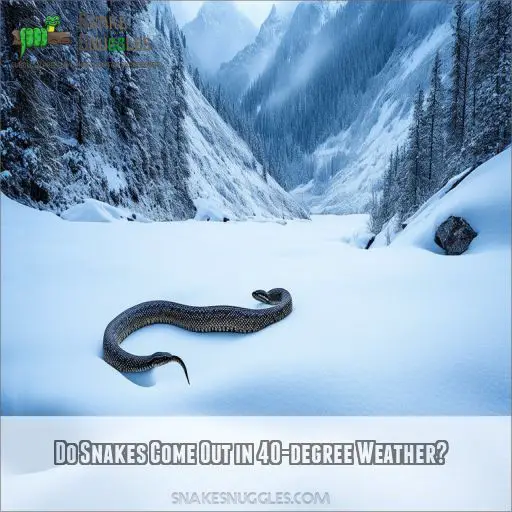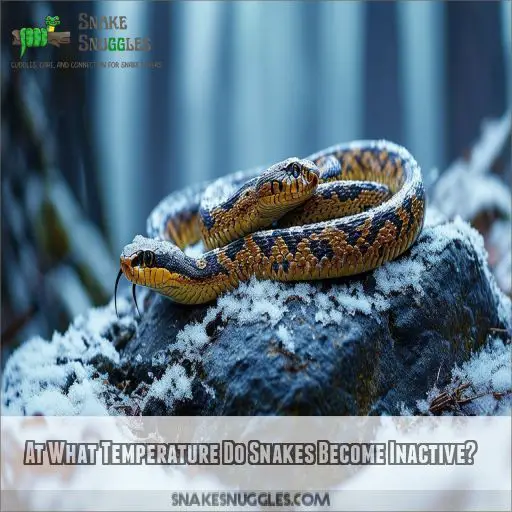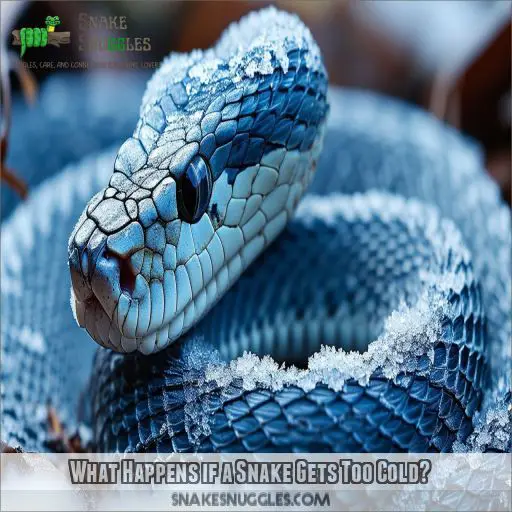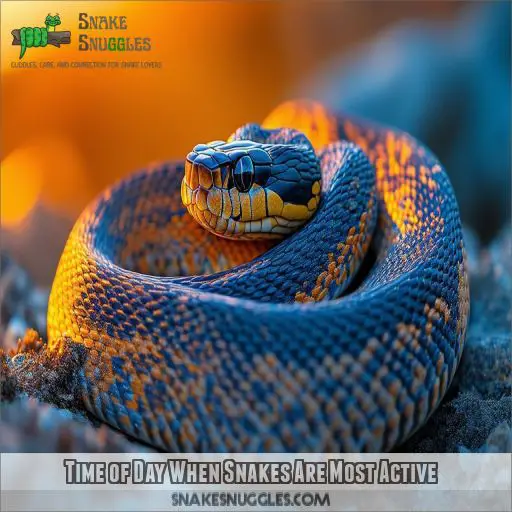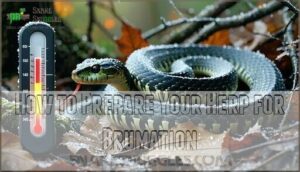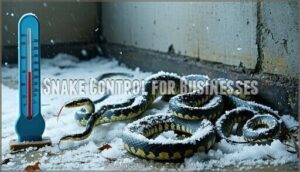This site is supported by our readers. We may earn a commission, at no cost to you, if you purchase through links.
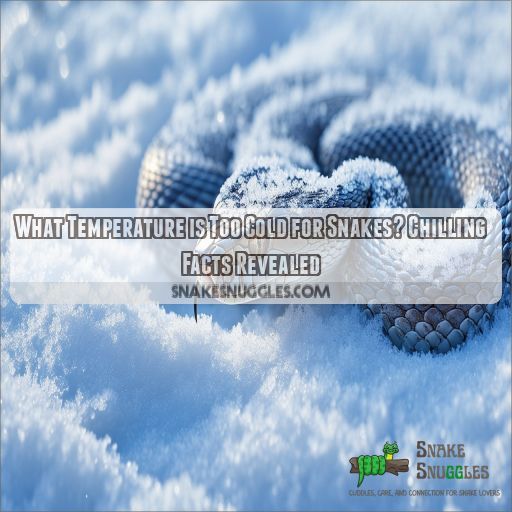 While they may seem impervious to cold, snakes are actually very sensitive to temperature. You may wonder, "What temperature is too cold for snakes?" Understanding that is important both for snake owners and for those who just want to avoid them.
While they may seem impervious to cold, snakes are actually very sensitive to temperature. You may wonder, "What temperature is too cold for snakes?" Understanding that is important both for snake owners and for those who just want to avoid them.
As ectothermic animals, they rely on an external source to raise their body temperature. They become lethargic and vulnerable when the temperatures get too low.
This article will shed light on the best understanding of these fascinating reptiles, focusing on the chilling facts associated with snake temperature tolerance.
Table Of Contents
- Key Takeaways
- What Temperature is Too Cold for Snakes?
- Do Snakes Come Out in 40-degree Weather?
- What is the Coldest Temperature a Snake Can Survive?
- At What Temperature Do Snakes Become Inactive?
- What Happens if a Snake Gets Too Cold?
- Time of Day When Snakes Are Most Active
- How to Prepare Your Herp for Brumation
- Snake Control for Businesses
- Frequently Asked Questions (FAQs)
- Do snakes come out in 40 degree weather?
- What is the coldest temperature a snake can survive?
- At what temperature do snakes become inactive?
- What happens if a snake gets too cold?
- Can snakes survive freezing temperatures inside their burrows?
- Do different snake species have varying cold tolerances?
- How quickly can snakes warm up after exposure?
- Can snakes sense temperature changes before they occur?
- Do baby snakes handle cold differently than adults?
- Conclusion
Key Takeaways
- Snakes are cold-blooded couch potatoes when temperatures dip below 50°F (10°C), becoming sluggish and seeking out warm hidey-holes to ride out the chill.
- While some tough-as-nails snake species can briefly tolerate near-freezing temps, most slithery friends prefer to keep things toasty above 50°F to avoid turning into snake-sicles.
- Brumation is a snake’s version of hitting the snooze button all winter long – they slow down their metabolism and catch some Zs in underground burrows or cozy crevices to survive the cold months.
- Just like how we bundle up in winter, snakes have their own cold-weather tricks – from basking in the sun on warmer days to seeking shelter in your garden shed (surprise!). But hey, no need to roll out the red carpet for these unexpected guests!
What Temperature is Too Cold for Snakes?
While most snakes go dormant when temperatures reach below 50°F, the threshold for "too cold" varies between species. Generally speaking, all snake species can withstand temporary periods in the 40-degree range.
A temperature below zero degrees Fahrenheit is invariably lethal to most species. More resilient species like the garter snake can survive a short time at slightly below 32°F.
As it gets cold, snakes go into a deep hibernation known as brumation, where their metabolism decreases to make use of as little energy as possible. Extreme cold can be fatal by rendering the snakes immobile and leading to death by freezing when they seek shelter and cannot find any.
These temperature limits are especially relevant for both snake care and control. Read more about how individual species of snakes cope with the cold.
Do Snakes Come Out in 40-degree Weather?
You might be surprised to learn that some snakes do venture out in 40-degree weather. While it’s not ideal for these cold-blooded creatures, certain species can tolerate chilly temperatures better than others. Garter snakes and cottonmouths, for instance, are more cold-hardy than their slithering counterparts.
On warmer winter days, you may spot snakes basking in the sun, trying to warm up their bodies. However, most snakes prefer to stay in their cozy brumation dens when it’s this cold. Brumation, unlike hibernation, allows snakes to wake up occasionally and move around.
What is the Coldest Temperature a Snake Can Survive?
Although most snake species can stand brief periods of weather in the 40-degree range, there’s an outer limit on cold tolerance. The temperature below which a snake can survive depends on the species, but most breeds die with prolonged exposure at temperatures lower than freezing. Some species of hardier snakes, such as garter snakes, are known to endure temperatures just below 32°F for small amounts of time. Even in this case, they aren’t frost-resistant.
To get through winter, most snakes go through brumation, which is closely related to hibernation. They’ll seek out dens that are below the frost line of the earth, where temperatures are relatively constant. These sites of brumation may include underground burrows, rock crevices, or even cellars created by humans.
During brumation, the metabolic rate of a snake is drastically lowered to preserve energy so that adaptation will keep them safe for survival and its ecology visualized in many benefits, including controlling rodent populations. When all is said and done, recall that extreme cold is something snakes are more or less helpless against.
At What Temperature Do Snakes Become Inactive?
You’ll notice snakes become less active as temperatures drop, typically around 50°F (10°C). Their metabolism slows, and they’re less likely to be out and about. But it’s not a hard and fast rule – some species are more cold-tolerant than others. Garter snakes and cottonmouths, for instance, can handle cooler temps better than their slithery cousins.
As the mercury dips, snakes start looking for cozy spots to brumate – it’s like hibernation, but with occasional wake-ups. This isn’t just a nap; it’s a survival strategy. Their bodies go into energy-saving mode, and they’ll hunker down in dens or other sheltered areas.
What Happens if a Snake Gets Too Cold?
When a snake gets too cold, its body functions slow down dramatically, and it can become immobile or even die. The specific temperature that’s too cold varies among snake species, with some able to tolerate near-freezing temperatures while others become inactive at higher temperatures.
Snake Cold Tolerance Variations
You’ve learned that snakes become inactive in cold temperatures, but did you know their cold tolerance varies? Some species can withstand near-freezing conditions, while others struggle below 50°F.
Snake metabolism slows dramatically as temperatures drop, affecting their physiology and survival. Adaptations like brumation help them endure winter, but extreme cold can be fatal.
A snake remover might find these reptiles seeking warmth in open pipes or other unusual spots during chilly weather.
Factors Influencing Snake Activity in Cold Weather
Now, having learned about snake cold tolerance, it becomes very pertinent to address what dictates their activity in cold weather. Snakes are brilliant creatures of thermoregulation and change their behaviors around temperature ranges. Rain, sunny conditions, and even an Indian summer may cause them to emerge from brumation.
Even though chemical snake repellents don’t work, rodent control and exclusion can help in snake control on your property without disrupting the basic role they play in keeping Lyme disease at bay.
Snake Vulnerability to Cold
You’ve seen how cold affects snake activity, but what happens if they get too cold?
Snakes are cold-blooded, meaning their body temperature matches their environment. If it drops too low, they can’t function properly. Unlike warm-blooded animals, snakes don’t generate their own heat.
In extreme cold, they may freeze to death if they can’t find shelter in a crawl space, rotting log, or tree stump for their deep sleep.
Snake Brumation Behavior
When the temperature becomes too cold, snakes go into brumation, a deep state of sleep. You may find them taking cover in:
- Basements with stone foundations
• Under leaf litter or logs
- Rocky crevices or tree stumps
- Human-made structures like sheds
Hibernation involves a slowing of metabolism to conserve energy. They may wake up on warm days but remain mostly inactive. However, this cold tolerance varies with species, and some will brumate for months at a time. Interestingly, research into snake venom during this period contributes to medical science advancements.
Time of Day When Snakes Are Most Active
Snakes are ectothermic, meaning their activity levels are closely tied to environmental temperatures. You’ll typically find snakes most active during warmer parts of the day when they can bask in the sun to regulate their body temperature, though some species may be more active at night in hot climates.
Snake Thermoregulation and Activity Patterns
You’ll find snakes are most active when temperatures suit their cold-blooded nature. They’re masters of thermoregulation, basking in the sun to warm up and seeking shade to cool down.
During hot days, they’re often nocturnal, while in cooler weather, they’ll bask during midday. Their activity patterns change with seasons.
When it’s chilly, they might even seek warmth in your garage, boiler room, or car engine.
Snake Behavior in Different Temperatures
Snakes will be seen using a variety of behaviors in order to thermoregulate as the temperatures fluctuate. The peak periods for activity are during the moderate temperatures, which are usually in the morning and evening. Basking is a means of thermoregulation, and hibernation is a way wherein the snake will survive the winter. Species differences come with differences in cold adaptation.
- Garter snakes may be active at lower temperatures than the other species
- Some snakes bask on warm surfaces in cool weather
- Night-active snakes might shift to daytime activity in colder months
How to Prepare Your Herp for Brumation
To prepare your reptile for brumation, you’ll need to gradually empty its digestive system and slowly acclimate it to cooler temperatures. Once these steps are complete, move your herp to a designated cool area where it can safely brumate for the winter months.
Prepare the Herp’s Digestive System
Gradually reducing feeding will help your herp’s digestive system prepare for brumation. Start by offering smaller meals every 10-14 days, then fast altogether about 2-3 weeks prior to brumation.
Always have some fresh water available for your reptile during this time.
This period of fasting allows the digestive tract to clean itself so that food doesn’t rot inside the herp while it’s in brumation.
Keep a very close eye on your herp’s weight and behavior during this transition period.
Acclimate the Reptile to Cooler Temperatures
To acclimate your reptile to cooler temperatures, you’ll need to create a temperature gradient. This process mimics natural cold tolerance adaptations and debunks hibernation myths. Gradually lower the ambient temperature over several weeks, allowing your herp’s metabolism to adjust. Here’s what you’ll observe:
- Decreased activity levels
- Reduced appetite
- Slower movements
- Preference for cooler areas
Move Your Reptile to a Cooler Area
In preparation for brumation, move your reptile to a cooler area. Over several weeks, slowly drop the temperature of its enclosure to simulate seasonal changes. Provide it with limited lighting and a warm hide box.
More important than all the other factors combined is fasting from food during this time. However, thoughtful management of temperature acclimation ensures the reptile will enter into this very important period in good health.
Sort of tuck them in for a nice, long winter’s nap!
Snake Control for Businesses
In case you have a business, you need to ensure a safe environment by having an effective snake control measure in place. Emphasize the elimination of likely snake habitat and food, while at the same time closing access points to your premises to prevent any intrusion by snakes.
Snake Removal and Prevention
Some of the reasons snake control is necessary for your business include safety snake identification and prevention.
Leave snakes alone; it’s not a job for anybody but the pros.
While snake migration may mean there will be an accidental encounter, proper snake relocation and rescue techniques ensure humane removal.
Be sure to check your grounds for potential snake breeding areas.
Integrated Pest Management for Snake Control
To effectively manage snakes, you’ll need an integrated pest control approach. This strategy combines snake exclusion techniques with broader pest management.
Start by sealing potential snake entry points around your business. Then, tackle the root cause – their food source. By controlling rodents and other prey, you’ll make your property less attractive to snakes.
Frequently Asked Questions (FAQs)
Do snakes come out in 40 degree weather?
While it’s rare, you might spot a snake at 40°F. They’re sluggish but can emerge briefly on warmer winter days. Most snakes prefer temperatures above 50°F for activity. Always be cautious and give them space if encountered.
What is the coldest temperature a snake can survive?
Like a bear in hibernation, snakes can survive surprisingly low temperatures. You’ll find most can’t endure below 50°F (10°C) for long. Some species, however, can withstand brief exposure to near-freezing conditions, though it’s risky for their survival.
At what temperature do snakes become inactive?
You’ll notice snakes become inactive around 50°F (10°C). At this temperature, their metabolism slows dramatically. They’ll seek shelter and may enter brumation if temperatures remain low. However, some species can tolerate colder conditions briefly.
What happens if a snake gets too cold?
If a snake gets too cold, its metabolism slows dramatically. You’ll notice reduced movement and responsiveness. In extreme cases, the snake’s organs can shut down, leading to death if it can’t warm up quickly enough.
Can snakes survive freezing temperatures inside their burrows?
While snakes can’t survive freezing, they’re surprisingly resilient. In burrows below the frost line, they’ll brumate safely. You’d be amazed how these cold-blooded creatures adapt, slowing their metabolism and conserving energy to endure winter’s chill.
Do different snake species have varying cold tolerances?
Yes, snake species have varying cold tolerances. You’ll find garter snakes and cottonmouths more cold-hardy than others. Some can survive near-freezing temps, while others struggle below 50°F. A snake’s habitat often determines its cold tolerance.
How quickly can snakes warm up after exposure?
Some snakes are capable of rising in body temperature suddenly depending on the immediate environment. You can see them basking in sunlight or searching for heat sources such as rocks, substrate, and the like.
It only takes minutes to hours for their bodies to reach the optimal temperature range.
Remember that the bigger the snake, the longer it will take to achieve this rise in temperature.
Can snakes sense temperature changes before they occur?
You’ll be amazed to learn that snakes can indeed sense temperature changes before they occur. They’ve got heat-sensing pits that detect infrared radiation, allowing them to anticipate shifts in their environment. It’s like they’ve got built-in weather forecasters!
Do baby snakes handle cold differently than adults?
Baby snakes handle cold differently than adults. You’ll find they’re more vulnerable to temperature drops, with less body fat and smaller size. They can’t regulate their body heat as effectively, so they’re at higher risk during cold snaps.
Conclusion
One needs to have a good understanding of what temperature is too cold for snakes, whether you’re a snake owner or someone who just wants to avoid the reptiles. You have learned how cold they can tolerate, when they’re active, and about brumation behavior.
In a nutshell, snake activity comes to a complete halt at certain temperatures, while some species generally tend to be more susceptible to cold than others.
Whether it’s getting your herp ready for brumation or taking control with snakes, this sort of knowledge certainly puts you at the helm of decision-making.
Respecting thermal requirements does much to keep the well-being of the snakes in line and allows for better management of encounters.


